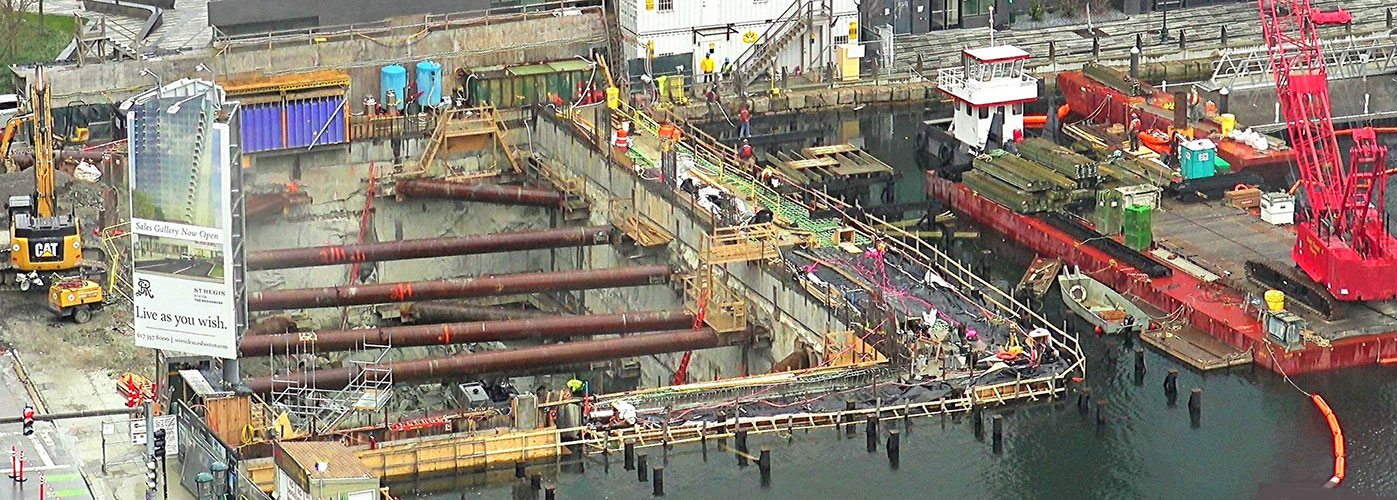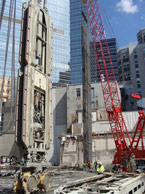FAQ
Bentonite is a sodium based clay with its main mineral component being montmorillonite, mined primarily in the northern plains states. Bentonite expands when wet, absorbing several times its dry mass in water. When dried bentonite powder is mixed with water, it forms a colloidal suspension, having the consistency of a thick milk shake. Slurry walls, slurry trenches, LBEs, and drilled shafts are constructed by excavating under bentonite slurry. The slurry stabilizes the excavation and prevents it from collapsing, even below the water table.
Cable suspended and hydraulic clamshells were the standard slurry wall excavation tools for over 50 years. Innovations in the industry have brought to the development of the hydromill technology. Hydromills offer high production rates in dense granular soils and most bedrock conditions. Penetration rates in these subsurface materials are substantially higher than with conventional cable suspended mechanical or hydraulic clamshells. However, they do not perform as well in cohesive soils, where the traditional clamshells tend to remain the tool of choice. Mobilization, operation, and ownership costs are significantly higher for the hydromill and therefore its use must be justified by soil and rock conditions and by the size of the project.
Issues that affect vibration levels include the type of soil or rock being excavated, the depth of excavation, the presence of water, the horizontal distance from the excavation to the monitoring point, and the type of excavation tool in use. However, there is no predictable correlation between vibration levels in surrounding structures and ongoing trench excavation. The effects of slurry trench excavation can be controlled to some extent by limiting the drop heights of the excavating tool and, in some applications, by using a hydromill.
Typically, maximum unbraced vertical bracing spans are limited to 10'-15'. However, depending on the elevation of the water table, the thickness of the slurry wall and the amount of reinforcing steel, unbraced vertical spans can be increased to about 25'. We have designed and installed post tensioned slurry walls for vertical spans in excess of 45'.
Circular and some elliptical shafts, constructed as slurry walls, typically require no internal bracing. Unbraced foundation excavations offer cost and scheduling advantages over conventionally braced excavations. Typically, the entire structure behaves as a self supporting compression ring. However, for very large diameters, in excess of 200', the structure behaves more like a thin shell structure, which may not accommodate deviations caused by typical construction tolerances and internal ring beams may be required.
Lateral movements depend on the lateral loads imposed on the slurry wall, the soils in which the slurry wall is installed and on the vertical span between bracing levels. Allowable lateral movements depend on the sensitivity to movement of structures and utilities in the vicinity of the slurry wall. Specified maximum allowable movements in congested urban areas are generally between 1 and 3.
The texture of the exposed face of slurry wall is directly related to the type of soil being excavated. Typically, fill materials create more irregularities in the finished surface, while cohesive and dense granular soils provide a relatively uniform surface. Skilled quality control of the bentonite slurry in the trench during excavation and of the excavation progress are key to the level of finish.
Several factors affect the decision on whether drilled shafts or LBEs are more cost effective. The type of soil and bedrock being penetrated, the distance of the top of rock from the working surface, and the design column loads are the most important considerations. Lighter column loads often dictate the use of drilled shafts. Heavier column loads and therefore greater penetrations into harder bearing soils and bedrock often make LBEs more efficient. Also, equipment mobilization and set up costs affect this decision. If slurry wall technology is already onsite, LBEs may be the foundation element of choice.
Top down construction offers significant construction scheduling advantages over a traditional construction building sequence by minimizing the amount of below ground construction work needed prior to commencing the superstructure. Initially, a perimeter slurry wall is constructed followed by installation of either circular drilled shafts or rectangular load bearing elements (LBEs) within the building footprint. The slurry wall acts as the permanent foundation wall and the drilled shafts or LBEs contain embedded structural steel columns that act as prefounded columns of the proposed high rise building. Once these elements are in place, mass excavation and basement slab construction can proceed from the ground level downward.
Up up construction also offers some construction scheduling advantages over a traditional construction building sequence. Typically, a perimeter slurry wall is constructed and is followed by mass excavation to the bottom of excavation (subgrade). Foundation elements, most often cast-in-place footings, are installed at subgrade, followed by placement of structural columns extending back up to grade. At this point, basement work can proceed from the bottom up, and superstructure work can start from the ground up, hence the term up-up.







